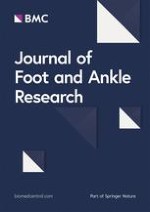Introduction
In vivo three-dimensional (3D) kinematics of the ankle joint is essential for a better understanding of its biomechanics and for many clinical applications. Several measurement techniques are available for this data, but few allow non-invasive measurements with sub-millimetre accuracy. The purposes of the study were to develop further a voxel-based 2D to 3D registration method [
1] for measuring 3D ankle kinematics with single plane fluoroscopy, and to determine experimentally the measurement errors
in vitro.
Methods
An ankle specimen was fixed with a plastic frame of high rigidity at eight different poses, encompassing the ankle range of motion during gait. The CT data and images from 20 fluoroscopy trials (Angiography, Advantx LCA, GE, France) of the specimen were obtained for each pose. 3D voxel-based models were derived from the CT data and then precisely registered to the 2D fluoroscopic images using an improved version of a voxel-based 2D to 3D registration method [
1]. With the method, the 3-D poses of the tibia, fibula, talus and calcaneus bones at each fluoroscopic image frame were obtained by searching the poses of the bone models, using an optimization procedure, the DRR of which best matched the fluoroscopic image according to a similarity measure. The poses obtained from a total of 160 fluoroscopic trials were compared to those determined by the CT data for measurement errors.
Results
High accuracies were found for the global poses of the tibia/fibula, talus and calcaneus; and the poses of the ankle and subtalar joints, Tables
1 and
2. The ensemble means (standard deviations) of the global tibial pose errors were less than 0.30 (0.55) mm, 1.10 (1.29) mm, and 0.46(0.79°) for the in-plane translation components, out-of-plane translation component, and all angular components, respectively. The corresponding values for the talus were 0.29 (0.57) mm, 0.07 (1.74) mm, and 0.19 (1.16)°, and those for the calcaneus were 0.39 (0.76) mm, 0.51 (1.29) mm, and 1.31 (0.71)°, Table
1.
Table 1
Ensemble means (standard deviations) of the global pose errors of the ankle bones
X(mm) | 0.31(0.24) | 0.29(0.22) | 0.13(0.77) |
Y(mm) | 0.01(0.55) | 0.04(0.57) | -0.39(0.74) |
Z(mm) | -1.10(1.29) | 0.07(1.74) | 0.51(1.29) |
θx(°) | -0.46(0.79) | 0.07(0.76) | -1.32(0.58) |
θy(°) | -0.09(0.64) | -0.15(1.16) | -0.51(0.64) |
θz(°) | -0.15(0.50) | 0.19(0.62) | 0.64(0.72) |
Table 2
The ensemble means (standard deviations) of the pose errors of the ankle and subtalar joints
X(mm) | -0.22(0.78) | 0.04(0.27) |
Y(mm) | -0.39(0.59) | 0.03(0.21) |
Z(mm) | 0.51(2.22) | 0.91(1.50) |
θx(°) | 1.39(1.03) | -0.53(0.75) |
θy(°) | 0.37(1.37) | 0.06(1.07) |
θz(°) | 0.44(0.87) | -0.33(0.81) |
The ensemble means (standard deviations) of the pose errors for the subtalar joint were less than 0.39 (0.78) mm, 0.50 (2.22) mm, and 1.38 (1.37)° for the in-plane translation components, out-of-plane translation component, and all angular components, respectively. The corresponding values for the ankle joint were 0.04 (0.27) mm, 0.90 (1.50) mm, and 0.53 (1.07)°.
Conclusion
The improved method has been shown experimentally to be accurate for the measurement of the 3D kinematics of the ankle complex with single plane fluoroscopy, the ensemble standard deviations of the errors (indicating the precision) being less than 0.78 mm for the in-plane translations, 2.22 mm for out-of-plane translation, and 1.37° for all rotations. This suggests that the method will be useful for the study of the ankle biomechanics and for relevant clinical applications.
Open AccessThis article is published under license to BioMed Central Ltd. This is an Open Access article is distributed under the terms of the Creative Commons Attribution 2.0 International License (
https://creativecommons.org/licenses/by/2.0), which permits unrestricted use, distribution, and reproduction in any medium, provided the original work is properly cited.
